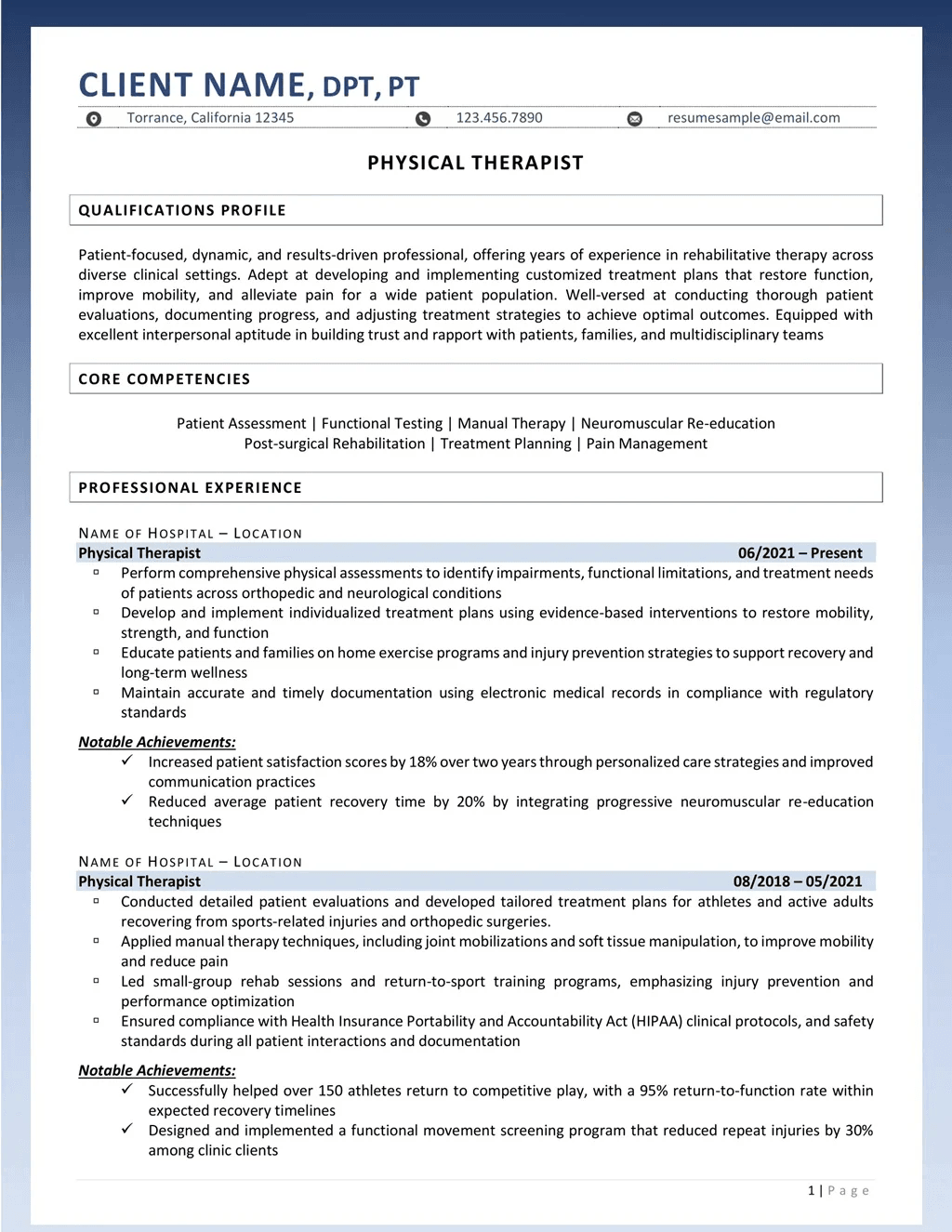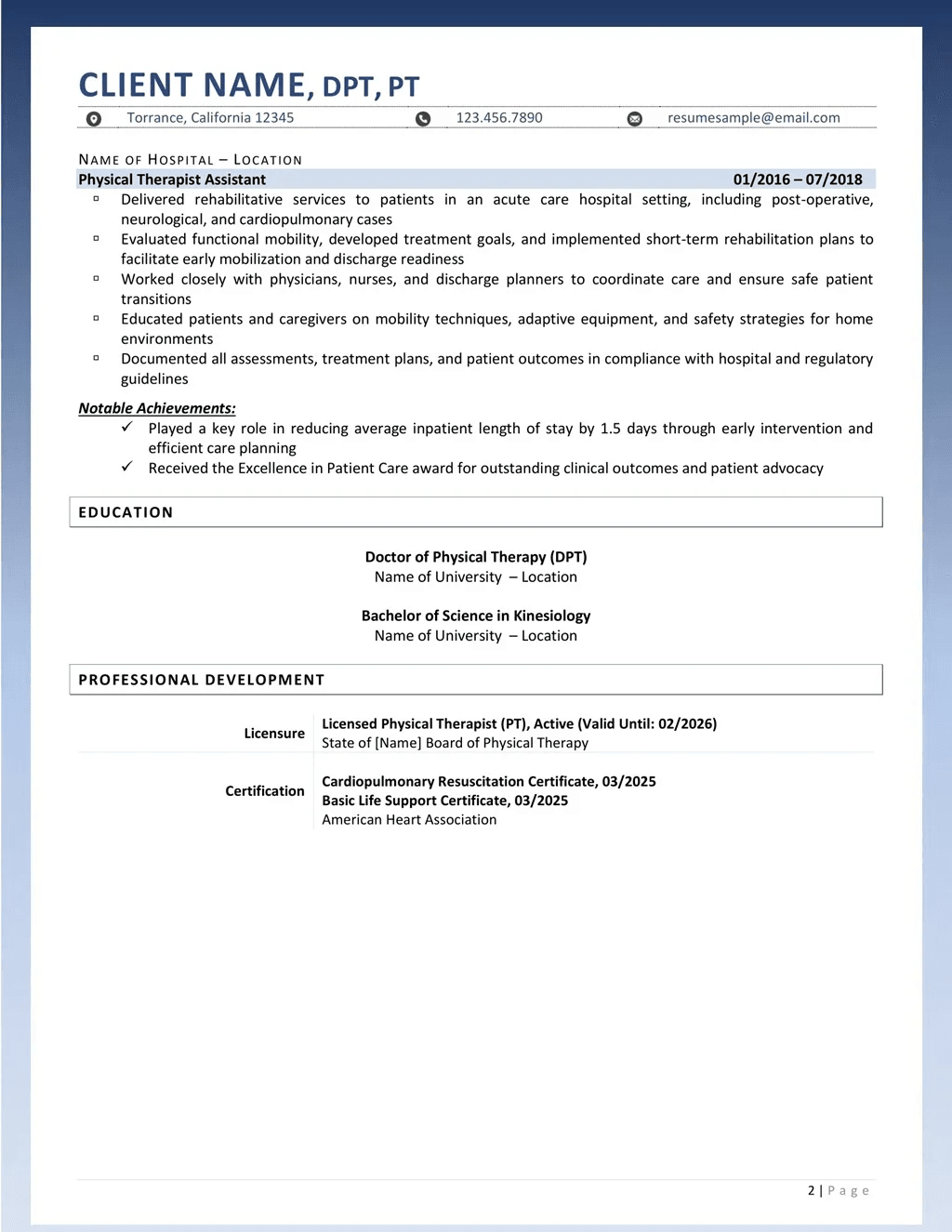If you’re a licensed physical therapist or a recent Doctor of Physical Therapy (DPT) graduate preparing to enter the workforce, crafting a well-structured and impactful resume is your gateway to securing a fulfilling role in this rapidly growing field. Whether you’re targeting opportunities in hospitals, rehabilitation centers, orthopedic clinics, sports facilities, or home healthcare agencies, your resume must showcase more than just your credentials—it needs to reflect your compassion, clinical expertise, and dedication to improving patient outcomes.
In this comprehensive guide, we’ll take you step-by-step through everything you need to know to build a winning physical therapist resume. You’ll learn about essential resume sections, formatting techniques, skills to emphasize, and powerful action verbs to make your resume pop. We’ll also provide expert tips for both entry-level and seasoned professionals—so you can position yourself as the top candidate.
Physical Therapist Resume Example
Creating an effective resume is key to landing your next role as a physical therapist. The example below highlights how to clearly present your clinical expertise, certifications, and patient care experience in a compelling format. Use it as a guide to craft a professional resume that showcases your strengths and aligns with the expectations of employers in the healthcare industry.


Download your own copy of the physical therapist resume example above.
Why a Strong Physical Therapist Resume Matters
The field of physical therapy offers high career satisfaction and significant job growth. According to the U.S. Bureau of Labor Statistics, employment for physical therapists is projected to grow 15% from 2022 to 2032, a rate much faster than the average for all occupations. This growth is driven by:
- An aging baby boomer population
- Increased awareness of physical wellness
- Greater demand for rehabilitative and preventive care
- Rising rates of chronic illnesses and mobility impairments
Despite growing opportunities, landing a position remains competitive. Healthcare employers often receive dozens of applications for each job opening, making your resume the first—and sometimes only—chance to make an impression. A compelling physical therapist resume helps you:
- Stand out in Applicant Tracking Systems (ATS)
- Capture the hiring manager’s attention within seconds
- Demonstrate your clinical qualifications and specialization
- Tailor your resume to the specific physical therapist position by highlighting relevant hard skills and experience that match the job description
- Reflect your passion for patient care and rehabilitation
- Communicate your ability to work as part of a healthcare team
How to Write a Physical Therapist Resume
Follow these steps to structure your resume effectively and highlight your most important qualifications and experiences. Choose the right physical therapist resume format—such as reverse chronological or combination—based on your experience and career goals, and be sure to include relevant skills tailored to the physical therapy field.
1. Choose the Right Resume Format
There are three common resume formats:
Choosing the best physical therapist resume format is essential to effectively highlight your experience and skills.
Reverse-Chronological (Recommended)
- Lists your most recent experience first.
- Ideal for showcasing career progression.
- Preferred by most recruiters and ATS systems.
Functional
- Focuses on skills rather than job history.
- Suitable for those with gaps in employment or career changers. Consider writing a narrative resume for a creative alternative approach.
Combination/Hybrid
- Blends functional and reverse-chronological formats.
- Good for candidates with some experience and a strong skill set.
Best choice for most physical therapists: Reverse-chronological.
2. Include These Key Resume Sections
a. Contact Information
Place this section at the top:
Clear contact information ensures the hiring manager can easily reach you during the hiring process.
- Full Name
- Phone Number
- Professional Email (avoid using nicknames or unprofessional handles)
- LinkedIn Profile (optional but helpful)
- City and State (no need for full mailing address)
b. Professional Summary or Objective
Your summary should be a short, impactful introduction that highlights your qualifications and aspirations.
Example:
Compassionate and results-driven experienced physical therapist and senior physical therapist with 7+ years of experience in outpatient rehab and orthopedic therapy. Dedicated physical therapist skilled in developing tailored treatment plans, restoring patient mobility, and collaborating with physical therapist assistants to enhance clinic efficiency. Demonstrated expertise in achieving positive patient outcomes and successful patient outcomes, with a proven track record of high patient satisfaction scores (95%+). Additional experience as a pediatric physical therapist and neurological clinical specialist, contributing to comprehensive patient care across diverse populations.
Objective (for new grads):
Recent DPT graduate with extensive clinical experience in orthopedic and neurorehabilitation settings. Eager to apply hands-on training and passion for patient care as a dedicated physical therapist, collaborating with physical therapist assistants to achieve positive patient outcomes and high patient satisfaction scores in a dynamic healthcare environment.
c. Licensure and Certifications
Clearly list all relevant credentials:
- State Licensure(s)
- NPTE status or license number
- CPR / BLS / First Aid certification
- Basic Life Support (BLS)
- Advanced Cardiac Life Support (ACLS)
- Specialty Certifications (e.g., OCS, NCS, SCS)
- Member, American Physical Therapy Association (APTA)
- Education doctor degree (DPT) or equivalent advanced training, if applicable
Example:
- Licensed PT – California (#123456)
- Passed NPTE, 2023
- Certified Orthopedic Clinical Specialist (OCS), APTA
- CPR & First Aid Certified – Red Cross
- Basic Life Support (BLS) Certified
- Advanced Cardiac Life Support (ACLS) Certified
- Member, American Physical Therapy Association (APTA)
- Doctor of Physical Therapy (DPT) – education doctor degree
d. Education
List your academic background in reverse chronological order:
- Degree (e.g., Doctor of Physical Therapy)
- University or Institution
- Graduation Date
- Honors or awards (if applicable)
- GPA (if 3.5+)
e. Clinical Experience or Work History
For each role, list:
- Job Title
- Employer
- Location
- Dates of Employment
- Bullet points describing responsibilities and accomplishments
Use metrics and outcomes whenever possible:
Developed and implemented individualized treatment plans for 20+ patients per week, resulting in a 30% improvement in functional mobility within 6 weeks.
- Collaborated with orthopedic surgeons to develop and optimize post surgical rehabilitation protocols, improving patient recovery times by 25%.
- Implemented orthopedic rehabilitation programs for patients with musculoskeletal injuries, leading to enhanced functional outcomes.
- Utilized pain management techniques and therapeutic modalities to reduce patient discomfort and accelerate recovery.
- Prescribed therapeutic exercises and home exercise programs tailored to individual patient needs, increasing adherence and supporting long-term rehabilitation.
- Led treatment planning and developing individualized treatment plans in collaboration with multidisciplinary teams.
- Tracked patient progress through regular assessments, adjusting care plans to maximize outcomes.
- Provided patient centered care to diverse patient populations, ensuring personalized and empathetic treatment approaches.
- Worked with the physical therapy department to implement new protocols and contribute to departmental initiatives.
- Assessed and treated patients with traumatic brain injuries and neurological disorders, including stroke and Parkinson’s disease, using evidence-based neurorehabilitation techniques.
- Managed sports related injuries, focusing on injury prevention, assessment, and rehabilitation for athletes.
- Applied constraint induced movement therapy in neurorehabilitation to improve motor function in patients with neurological deficits.
f. Skills Section
Organize your skills into categories like:
- Technical Skills
- Therapeutic Techniques
- Interpersonal/Soft Skills
- Technology/Systems
When creating your skills section, be sure to include relevant skills and specific physical therapist skills that match the job description. This helps your resume pass applicant tracking systems and demonstrates your fit for the position.
In the Technical Skills category, consider listing physical therapy techniques and cardiopulmonary physical therapy to showcase your specialized expertise.
Tailor this section to include keywords from the job posting.
g. Optional Sections
- Professional Affiliations: APTA, regional PT organizations, pediatric physical therapy programs, geriatric physical therapy associations
- Specialized Experience: Pediatric Physical Therapy, Geriatric Physical Therapy
- Languages: Especially useful in multicultural areas
- Continuing Education: Courses, certifications, or workshops
- Volunteer Work: Relevant community outreach or medical missions
Tailoring Your Resume to the Job Description
A tailored resume is much more effective than a generic one. To customize your resume:
- Use the job title from the listing in your resume summary.
- Match keywords and phrases from the job ad.
- Align your experience with requirements stated in the posting, including the specific physical therapy services highlighted by the employer, such as sports medicine or orthopedics.
- Highlight specific experience with patient populations or settings mentioned.
Example:If the job posting emphasizes “neurological rehabilitation,” include examples of treating patients post-stroke or with spinal cord injuries.
Best Hard and Soft Skills for Physical Therapists
Highlighting the right mix of technical expertise and interpersonal abilities can greatly increase your appeal to hiring managers.
Hard Skills
- Orthopedic & Neurological Rehabilitation
- Manual Therapy Techniques (e.g., myofascial release, joint mobilization)
- Therapeutic Exercise Prescription
- Gait Training and Balance Reeducation
- Post-Surgical Recovery Plans
- Pediatric & Geriatric PT
- EMR Systems: WebPT, Epic, Meditech
- Functional Movement Assessments (FMS, SFMA)
- Electrotherapy & Modalities
- Kinesiology Taping
Soft Skills
- Patient-Centered Communication
- Active Listening & Emotional Support
- Team Collaboration
- Cultural Competency
- Time Management
- Conflict Resolution
- Adaptability & Flexibility
- Problem-Solving
- Leadership (for supervisory roles)
Resume Tips for Entry-Level Physical Therapists
If you’re just starting your career, focus on your clinical training and education:
- Highlight Clinical Rotations: Name the facility, duration, population treated, and key contributions.
- Mention DPT Research Projects or Capstone Work
- Include GPA or Academic Honors (if strong)
- Showcase Transferable Skills: Communication, teamwork, and initiative.
- Include Experience as a Physical Therapist Assistant: If applicable, describe your role supporting licensed physical therapists, assisting with patient care, and contributing to clinic efficiency.
Sample bullet point:
Completed 10-week inpatient clinical rotation treating post-stroke and TBI patients using evidence-based neurorehabilitation techniques; achieved measurable progress in 85% of cases.
Resume Tips for Experienced Physical Therapists
If you’ve been practicing for years:
- Emphasize Impact and Outcomes
- Include metrics (e.g., satisfaction scores, therapy success rates)
- Showcase leadership, mentorship, or training experience
- List any programs or systems you’ve implemented or improved
Example bullet point:
Spearheaded fall prevention program in skilled nursing facility, resulting in a 40% reduction in fall-related injuries over 12 months.
Powerful Action Verbs for Your Resume
Use these verbs to start your bullet points and convey achievement:
- Assessed
- Diagnosed
- Treated
- Developed
- Designed
- Implemented
- Facilitated
- Rehabilitated
- Monitored
- Prescribed
- Documented
- Educated
- Collaborated
- Optimized
- Supervised
- Coordinated
- Evaluated
- Adapted
- Led
- Streamlined
Common Resume Mistakes to Avoid
Avoid these pitfalls to ensure a polished, professional presentation:
- Using overly technical language
- Ignoring ATS compatibility (avoid images, text boxes, fancy fonts)
- Submitting the same resume everywhere
- Focusing only on responsibilities, not accomplishments
- Typos and grammatical errors
- Including irrelevant job experiences
- Listing outdated or expired certifications
Additional Tips for Job Search Success
Complement your resume with a strategic job search approach to increase your chances of landing the perfect role.
1. Always Include a Cover Letter
- Personalize it for each application.
- Mention the role and how your background aligns with it.
- Highlight 2–3 accomplishments or traits that make you stand out.
2. Optimize for ATS
- Use standard headings: Education, Experience, Skills, etc.
- Include exact keywords from the job description.
- Avoid fancy formatting—stick to clean, simple layouts.
3. Be Concise but Comprehensive
- Aim for 1–2 pages
- Prioritize recent, relevant experiences
- Remove outdated or unrelated job history
4. Keep Formatting Clean and Consistent
- Match font sizes and spacing
- Use bullet points consistently
- Align dates and job titles clearly
Get Expert Help Crafting Your Physical Therapist Resume
Writing a strong physical therapist resume requires more than listing your education and work history. It’s about showcasing your clinical experience, treatment expertise, and patient care philosophy in a way that resonates with healthcare employers. If you’re not sure how to position your unique strengths or want to ensure your resume stands out in a competitive job market, partnering with a professional can make all the difference.
Look no further! We understand the nuances of physical therapy careers. Our expert resume writers are skilled in highlighting your hands-on experience with patient evaluation, manual therapy, rehabilitation planning, and interdisciplinary collaboration. We know what hiring managers look for in hospitals, clinics, and home health settings, and we tailor each resume to reflect your specific expertise and career goals.
Contact us today and let us help you create a resume for physical therapists that not only meets industry standards but also clearly communicates your impact.








